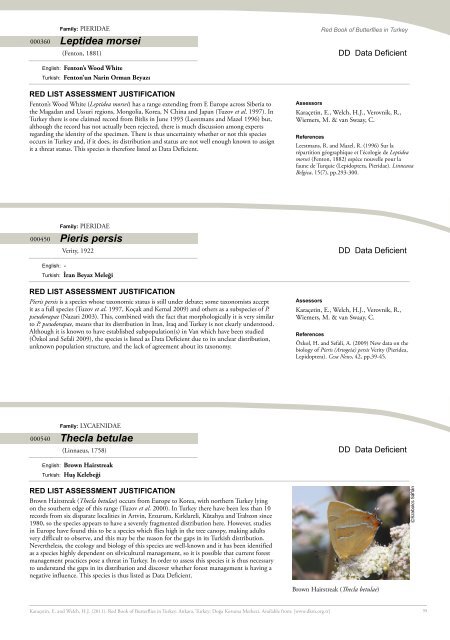Red Book of Butterflies in Turkey Red Book of Butterflies in Turkey
Red Book of Butterflies in Turkey Red Book of Butterflies in Turkey
Red Book of Butterflies in Turkey Red Book of Butterflies in Turkey
Create successful ePaper yourself
Turn your PDF publications into a flip-book with our unique Google optimized e-Paper software.
000360<br />
000450<br />
000540<br />
Family: PIERIDAE<br />
Leptidea morsei<br />
(Fenton, 1881)<br />
English: Fenton’s Wood White<br />
Turkish: Fenton’un Nar<strong>in</strong> Orman Beyazı<br />
RED LIST ASSESSMENT JUSTIFICATION<br />
Fenton’s Wood White (Leptidea morsei) has a range extend<strong>in</strong>g from E Europe across Siberia to<br />
the Magadan and Ussuri regions, Mongolia, Korea, N Ch<strong>in</strong>a and Japan (Tuzov et al. 1997). In<br />
<strong>Turkey</strong> there is one claimed record from Bitlis <strong>in</strong> June 1993 (Leestmans and Mazel 1996) but,<br />
although the record has not actually been rejected, there is much discussion among experts<br />
regard<strong>in</strong>g the identity <strong>of</strong> the specimen. There is thus uncerta<strong>in</strong>ty whether or not this species<br />
occurs <strong>in</strong> <strong>Turkey</strong> and, if it does, its distribution and status are not well enough known to assign<br />
it a threat status. This species is therefore listed as Data Deficient.<br />
Family: PIERIDAE<br />
Pieris persis<br />
Verity, 1922<br />
English: -<br />
Turkish: İran Beyaz Meleği<br />
RED LIST ASSESSMENT JUSTIFICATION<br />
Pieris persis is a species whose taxonomic status is still under debate; some taxonomists accept<br />
it as a full species (Tuzov et al. 1997, Koçak and Kemal 2009) and others as a subspecies <strong>of</strong> P.<br />
pseudorapae (Nazari 2003). This, comb<strong>in</strong>ed with the fact that morphologically it is very similar<br />
to P. pseudorapae, means that its distribution <strong>in</strong> Iran, Iraq and <strong>Turkey</strong> is not clearly understood.<br />
Although it is known to have established subpopulation(s) <strong>in</strong> Van which have been studied<br />
(Özkol and Sefali 2009), the species is listed as Data Deficient due to its unclear distribution,<br />
unknown population structure, and the lack <strong>of</strong> agreement about its taxonomy.<br />
Family: LYCAENIDAE<br />
Thecla betulae<br />
(L<strong>in</strong>naeus, 1758)<br />
English: Brown Hairstreak<br />
Turkish: Huş Kelebeği<br />
RED LIST ASSESSMENT JUSTIFICATION<br />
Brown Hairstreak (Thecla betulae) occurs from Europe to Korea, with northern <strong>Turkey</strong> ly<strong>in</strong>g<br />
on the southern edge <strong>of</strong> this range (Tuzov et al. 2000). In <strong>Turkey</strong> there have been less than 10<br />
records from six disparate localities <strong>in</strong> Artv<strong>in</strong>, Erzurum, Kırklareli, Kütahya and Trabzon s<strong>in</strong>ce<br />
1980, so the species appears to have a severely fragmented distribution here. However, studies<br />
<strong>in</strong> Europe have found this to be a species which flies high <strong>in</strong> the tree canopy, mak<strong>in</strong>g adults<br />
very difficult to observe, and this may be the reason for the gaps <strong>in</strong> its Turkish distribution.<br />
Nevertheless, the ecology and biology <strong>of</strong> this species are well-known and it has been identified<br />
as a species highly dependent on silvicultural management, so it is possible that current forest<br />
management practices pose a threat <strong>in</strong> <strong>Turkey</strong>. In order to assess this species it is thus necessary<br />
to understand the gaps <strong>in</strong> its distribution and discover whether forest management is hav<strong>in</strong>g a<br />
negative <strong>in</strong>fluence. This species is thus listed as Data Deficient.<br />
Karaçet<strong>in</strong>, E. and Welch, H.J. (2011). <strong>Red</strong> <strong>Book</strong> <strong>of</strong> <strong>Butterflies</strong> <strong>in</strong> <strong>Turkey</strong>. Ankara, <strong>Turkey</strong>: Doğa Koruma Merkezi. Available from: [www.dkm.org.tr]<br />
<strong>Red</strong> <strong>Book</strong> <strong>of</strong> <strong>Butterflies</strong> <strong>in</strong> <strong>Turkey</strong><br />
DD Data Deficient<br />
Assessors<br />
Karaçet<strong>in</strong>, E., Welch, H.J., Verovnik, R.,<br />
Wiemers, M. & van Swaay, C.<br />
References<br />
Leestmans, R. and Mazel, R. (1996) Sur la<br />
répartition géographique et l’écologie de Leptidea<br />
morsei (Fenton, 1882) espèce nouvelle pour la<br />
faune de Turquie (Lepidoptera, Pieridae). L<strong>in</strong>neana<br />
Belgica, 15(7), pp.293-300.<br />
DD Data Deficient<br />
Assessors<br />
Karaçet<strong>in</strong>, E., Welch, H.J., Verovnik, R.,<br />
Wiemers, M. & van Swaay, C.<br />
References<br />
Özkol, H. and Sefali, A. (2009) New data on the<br />
biology <strong>of</strong> Pieris (Artogeia) persis Verity (Pieridea,<br />
Lepidoptera). Cesa News, 42, pp.39-45.<br />
DD Data Deficient<br />
Brown Hairstreak (Thecla betulae)<br />
©Szabolcs Sáfián<br />
99


